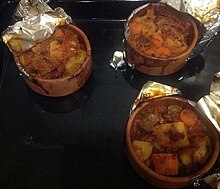Ghivetch (Bulgarian: гювеч, [ɟuˈvɛtʃ], Romanian: ghiveci, [ɡivet͡ʃʲ], Turkish: güveç, Serbo-Croatian: đuveč / ђувеч [ˈd͡ʑǔʋɛt͡ʃ], Macedonian: ѓувеч, [ˈɟuvɛtʃ]) is a traditional Balkan autumn vegetable stew most closely associated with Moldova, where it is a national dish, and Bulgaria. It is traditionally cooked in an earthenware pot called a güveç. It is often made only with vegetables, though some versions include meat, fish, or poultry. The Washington Post in 1985 called it "one of the world's great vegetable melanges". Mimi Sheraton called it "really the last word in vegetable stews".

Origins
editGhivetch is known throughout the Balkans as a traditional autumn vegetable stew, but it is most closely associated with Moldova and Bulgaria.[1][2] It is a national dish of Moldova, where it is called ghiveci.[3] It is a dish eaten by Danube Swabians.[4]
Ingredients
editGhivetch is often made only with vegetables, sometimes as many as 40, but versions exist that include meat, fish, poultry and dairy.[1][2] In the Western Balkans it is often consumed with rice.
Mimi Sheraton, writing in the Wall Street Journal, described it as traditionally including "some pleasing pucker" from the inclusion of grape leaves or other sour ingredients such as sour salt, and paprika, either hot or sweet.[2]
Preparation and serving
editTraditionally the stew is prepared in a clay pot called a güveç, duvech,[5] or gyuvech;[citation needed] in Greece the pot is called yiouvetsi.[5] According to Paula Wolfert the pot is "beloved for its ability to impart a great earthy taste and aroma".[5] Traditionally the dish is assembled at home, then taken to a local bakery, and delivered to the customer by a delivery boy wearing a cushion on his head.[5] Truck delivery has replaced the delivery boys.[5] Some specialty bakeries allow customers to order ghivetch to be assembled by the bakery rather than by the customer at home; customers return the empty pot to the bakery.[5]
Ghivetch can be served hot or cold.[2] It is sometimes pureed.[2] It is often garnished with sour cream or yogurt.[2]
Importance
editThe Washington Post in 1985 called it "one of the world's great vegetable melanges", along with Buddha's delight, ratatouille, and moussaka.[1] The New York Times in 1977 specifically distinguished it as one of the mixed-vegetable stews characteristic of various cuisines.[6] Sheraton called it "really the last word in vegetable stews" and included it in her book 1000 Foods to Eat Before You Die.[6][7]
Similar and related dishes
editRelated dishes
editOther mixed-vegetable dishes
editReferences
edit- ^ a b c Farrington, Sharon (13 October 1985). "Romanian Vegetable Melange". Washington Post. ISSN 0190-8286. Retrieved 10 January 2022.
- ^ a b c d e f g Sheraton, Mimi (3 September 2015). "Recipes for Getting the Best Return on a Surplus of Vegetables". Wall Street Journal. ISSN 0099-9660. Retrieved 10 January 2022.
- ^ "Ghivetch". The New York Times. 1983-12-14. ISSN 0362-4331. Retrieved 2022-01-11.
- ^ "Juwetsch with Beef by Tina Leto | Cooking Donauschwaben Style!". www.dvhh.org. Retrieved 2023-09-15.
- ^ a b c d e f Wolfert, Paula (2009). Mediterranean clay pot cooking : traditional and modern recipes to savor and share. Hoboken, N.J.: John Wiley & Sons. pp. 88, 133. ISBN 978-0-7645-7633-1. OCLC 298538015.
- ^ a b c ". . . And Just See How Exotic the Vegetables Can Be". New York Times. 22 June 1977.
- ^ Sheraton, Mimi (2 September 2015). "Ghivetch". Wall Street Journal. ISSN 0099-9660. Retrieved 10 January 2022.